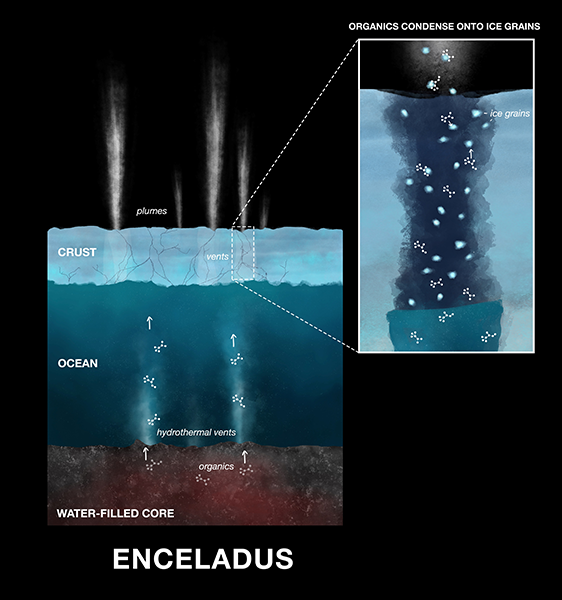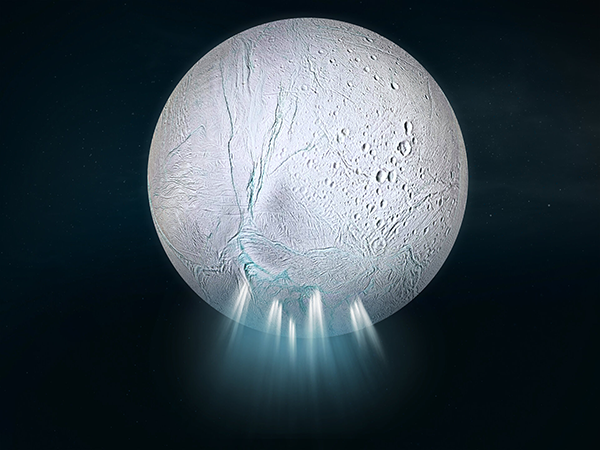Two complementary studies shed light on the chemical origins of organic molecules erupting from the subsurface ocean of Saturn’s moon Enceladus. In situ observations from Cassini revealed a diverse set of organics in freshly ejected plume grains, while new laboratory simulations reproduce possible hydrothermal and freezing pathways for their synthesis. Together, these findings
suggest that Enceladus’s ocean is an active chemical reactor, capable of generating biologically relevant molecules and preserving them during their journey to space.

Saturn’s moon Enceladus has long been considered one of the most promising places in the Solar System to search for signs of life. The Cassini spacecraft revealed that this small icy moon hosts a global subsurface ocean beneath its frozen shell, venting water, salts, and organic material through geyser-like plumes. Two recent studies—one based on re-analysed spacecraft data and the other on laboratory simulations—provide crucial new insights into the chemical complexity of this ocean world.
In the first study, Nozair Khawaja (University of Stuttgart, currently at Freie Universität Berlin), Frank Postberg (Freie Universität Berlin), Yasuhito Sekine (ELSI), Maxwell Craddock (ELSI) and colleagues analysed mass spectra collected during Cassini’s fastest fly-by of Enceladus (E5). Unlike earlier observations of older E-ring particles, these spectra captured ice grains ejected only minutes earlier from the subsurface ocean. The unprecedented encounter speed of nearly 18 km/s fragmented molecules in new ways, revealing previously unseen signals of aromatic compounds, esters, ethers, and nitrogen- and oxygen-bearing organics. Their presence directly in the plume rules out space weathering as the sole origin, pointing instead to hydrothermal chemistry deep inside Enceladus. Such processes may mirror those on Earth’s seafloor, where hydrothermal vents drive the transformation of simple molecules into complex organic precursors.
The second study, led by ELSI graduate student Craddock with Sekine, Khawaja, Postberg, and collaborators, reproduces these processes under controlled laboratory conditions. Using high-pressure autoclaves and cryogenic freezers, the team simulated Enceladus-like conditions with mixtures of CO₂, NH₃, CH₄, HCN, and phosphates. They found that hydrothermal reactions at up to 150 °C readily produced amino acids, aldehydes, and nitriles, while freezing cycles generated additional simple amino acids such as glycine. Notably, when their reaction products were tested with a laser-induced mass spectrometer mimicking Cassini’s Cosmic Dust Analyzer, the resulting spectra closely resembled spacecraft observations. However, while amino acids were abundant in the laboratory runs, their signals have not yet been detected in plume ice grains—suggesting that partitioning into salt-rich particles or subsequent alteration may obscure their presence.
Together, these studies strengthen the case that Enceladus’s ocean is both chemically diverse and dynamically active. The detection of aromatic and oxygen-bearing groups in fresh plume material implies ongoing hydrothermal processing, while laboratory simulations demonstrate plausible pathways for amino acid formation under moon-like conditions. At the same time, the inability to reproduce Enceladus’s large macromolecular organics in the laboratory suggests that additional processes—such as high-temperature catalysis or inheritance of primordial carbon—may also play a role.
Looking ahead, these findings help define priorities for future missions. A spacecraft capable of directly sampling Enceladus’s plumes with more advanced instruments could test for isotopic signatures, confirm the presence of amino acids, and determine whether complex macromolecules are products of hydrothermal synthesis or remnants of primordial building blocks. Such data would be critical for assessing Enceladus’s habitability and the broader question of whether life can emerge in ocean worlds beyond Earth.

| Journal | Nature Astronomy |
| Title of the paper | Detection of organic compounds in freshly ejected ice grains from Enceladus’s ocean |
| Authors | Nozair Khawaja1,6*, Frank Postberg2, Thomas R. O’Sullivan2, Maryse Napoleoni2, Sascha Kempf3, Fabian Klenner4, Yasuhito Sekine5, Maxwell Craddock5, Jon Hillier2, Jonas Simolka1, Lucía Hortal Sánchez2 & Ralf Srama1 |
| Affiliations | 1. Institute of Space Systems, University of Stuttgart, Stuttgart, Germany 2. Freie Universität Berlin, Institute of Geological Sciences, Berlin, Germany 3. Laboratory for Atmospheric and Space Physics, University of Colorado, Boulder, CO, USA 4. Department of Earth and Space Sciences, University of Washington, Seattle, WA, USA 5. Earth-Life Science Institute (ELSI), Institute of Science, Tokyo, Japan 6. Present address: Freie Universität Berlin, Institute of Geological Sciences, Berlin, Germany |
| DOI | https://doi.org/10.1038/s41550-025-02655-y |
| Online published date | 1 October 2025 |
| Journal | Icarus |
| Title of the paper | Laboratory simulations of organic synthesis in Enceladus: Implications for the origin of organic matter in the plume |
| Authors | Maxwell L. Craddocka*, Yasuhito Sekinea, b, c, Maryse Napoleonid, Nozair Khawajae, d, Shuya Tanf, Yamei Lia, Zening Yanga, Lucía Hortal Sánchezd, Ruiqin Yig, Frank Postbergd |
| Affiliations | a. Earth-Life Science Institute (ELSI), Institute of Science Tokyo, Japan b. Institute of Nature and Environmental Technology, Kanazawa University, Japan c. Planetary Plasma and Atmospheric Research Center, Tohoku University, Japan d. Freie Universität Berlin, Institute of Geological Sciences, Germany e. Institute of Space Systems, University of Stuttgart, Germany f. Super-cutting-edge Grand and Advanced Research (SUGAR) program, Institute for Extra-cutting-edge Science and Technology Avant-garde Research (X-star), Japan Agency for Marine-Earth Science and Technology (JAMSTEC), Japan g. State Key Laboratory of Deep Earth Processes and Resources, Guangzhou Institute of Geochemistry, Chinese Academy of Sciences, China |
| DOI | https://doi.org/10.1016/j.icarus.2025.116836 |
| Online published date | 1 October 2025 |
